Here’s some more GoPro footage from the Van Isle trip, heading back east in the Strait of Juan de Fuca from Port Renfrew to Becher Bay.
Be sure to watch in 1080p HD if you’re on a fast connection.

Here’s some more GoPro footage from the Van Isle trip, heading back east in the Strait of Juan de Fuca from Port Renfrew to Becher Bay.
Be sure to watch in 1080p HD if you’re on a fast connection.
We were ghosting into the entrance to Matilda Inlet, before the point blocked the remainder of a 5 knot breeze. Fingers of wispy clouds intertwined with the dense evergreen shore. As we lost all wind, a light rain started.
We motored about a mile south, past the tiny town of Ahousat, into the right (west) fork of the inlet. There were no other boats there. We dropped anchor in about 15 feet, the anchor setting easily – a welcome luxury after recent deeper anchorages (we don’t have a powered windlass and it’s a lot of work pulling up 100+ feet of chain later).
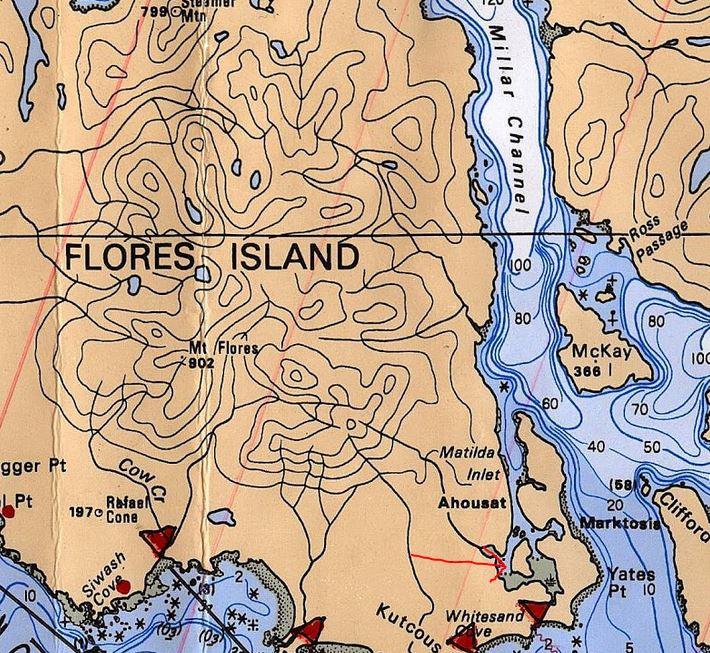
Matilda Inlet in the lower right – we anchored in the left fork where I drew a red arrow.
(Note chart not intended for navigation)
After turning off the engine, Natalie said “Do you hear that?”
“What?” I said. “I don’t hear anything.”
“Exactly,” she said. “It’s silent here.”
And it was. We had only the sounds of nature – a couple birds chirping, a slight breeze blowing through the trees.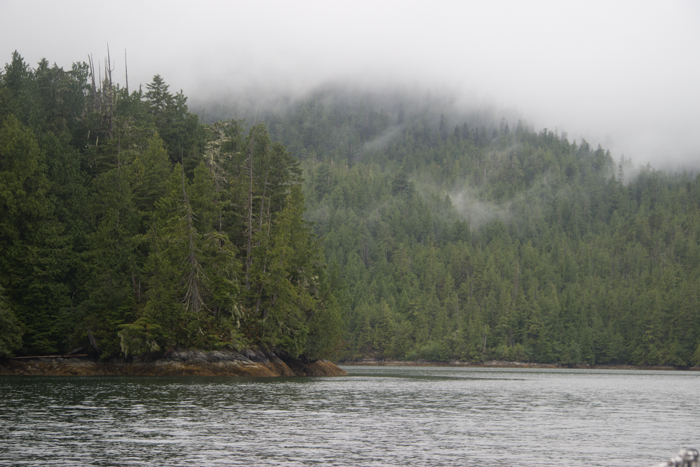
It seems a silly thing to find notable, but most anchorages we’re used to aren’t that silent – with 4 or 5 other boats present (or 15+ for the big ones), you hear voices, generators, loose lines slapping against rigging, etc.
Matilda Inlet had a magical feel to us. An anchorage so perfect it felt like we had discovered a secret paradise. It’s completely protected inside a mile long inlet, surrounded by lush evergreen forest, and a family of four eagles kept us company soaring majestically over our heads. A man-made bathing pool on the shore is a short dinghy ride away. A rainforest-like hiking trail leads to a beach where you can find a sea cave.
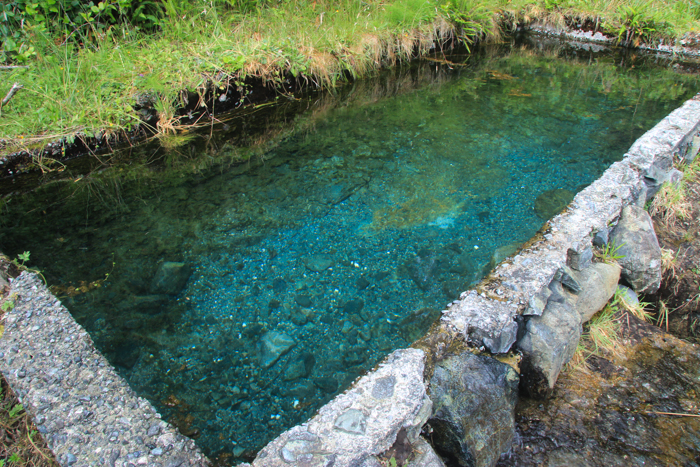
The man-made pool at Matilda Inlet


We liked it so much we stayed a second night. The first night we shared the anchorage with one other sailboat, and the second night had it all to ourselves.
If we had to pick one reason it was worth going to Clayoquot Sound, it’d have to be the empty anchorages. Heelboom Bay was another one we had all to ourselves. Of 6 nights at anchor in Clayoquot, two nights we were alone and three nights we had only one other boat present. Only one anchorage had more than one boat besides ours (Hot Springs Cove).
There’s something really special about having an anchorage all to yourself. It’s a true feeling of seclusion, peace and quiet, and oneness with nature.
Heelboom Bay had the most spectacular sunset of the trip. As the evening progressed, the sunset just got better and better. At 9pm I was thinking “this is a pretty good sunset.” By 9:30 I was thinking “wow, this is the best sunset I’ve ever seen!”
The sunset was reflecting off clouds onto the water in almost a 180 degree arc, with our view out the bay open to the east – looking upon the mountain ranges of Vancouver Island.
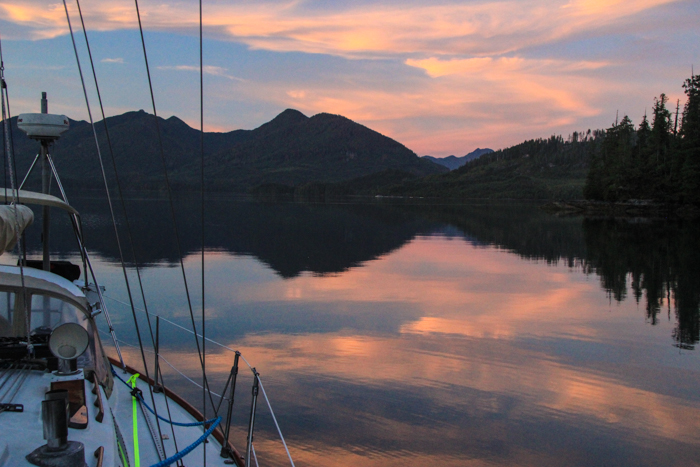
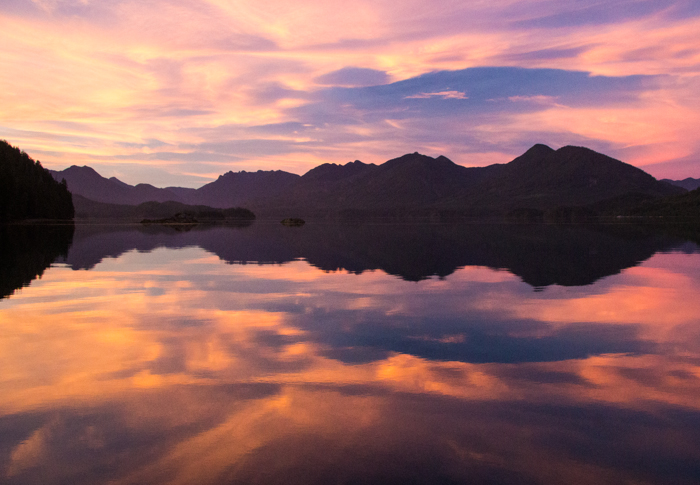
Check out my GoPro video on YouTube (turn on HD quality if you’re on decent Internet), which also includes footage from our sail to Bamfield the following week:
This might have been the first time I knew real fear. We were having engine problems in the Strait of Juan de Fuca in 4 foot ocean rollers and no wind. Our engine power was dropping randomly, and at this point I had no clue why.
I’m not a person who frightens easily. Rock climbing, mountaineering, auto racing on a track, roller coasters – those things I would hardly even call scary. The only two things I’ve ever really found scary were skydiving and spelunking (caving, but in a random cave in PA where we crawled through tiny shoulder-width passages and the fear of getting trapped was very real).
But with our engine acting up in the Strait and no wind to sail, I began to realize how truly on our own we were. There was no easy rescue. If our engine completely failed we’d be stuck doing 360’s in ocean waves getting seasick for maybe hours before we could get Vessel Assist or a Coast Guard tow.

If you’ve never been out the Strait of Juan de Fuca before, the first thing you need to know about it is that it’s much bigger and more remote than you probably realize. In the whole day we hadn’t seen any other sailboats until the last hour, and there aren’t many safe anchorages you can pull into if something goes wrong.
Our lives weren’t in any danger. This wasn’t a real crisis compared to the life or death situations some sailors have been through. Yet it was still scary.
With time to think, and a quick check of the engine troubleshooting table in the Don Casey book, it was pretty clear it was probably a clogged fuel filter. But, I couldn’t help worry about all the other things it could maybe be – what if this was some weird, hard to fix issue rather than the fuel filter? What if the engine was actually overheating and our temperature alarm was broken? What if the fuel lift pump was broken? An air leak in the fuel lines? Would we continue on to the outside of Vancouver Island only to find the engine failing again in an even more remote location?
We shut down the engine and I did an inspection. With the lack of wind and the 4’ rollers, the boat quickly turned beam to the waves, which made below decks work fairly seasickness inducing.
I really didn’t want to try changing the fuel filter at sea. We restarted the engine, and were able to get it to run fine at a low cruising rpm (1800-1900). We slowly motored the last hour into Neah Bay.

Maybe it was our engine problems, or the gray chilly weather, but we found Neah Bay very glum and depressing
As I motored towards a dilapidated-looking unattended fuel dock, the engine died. Bad timing. Restart engine, died again. Ugh! Okay, what now? We’re 100 feet from the fuel dock, in 15 knots of wind (blowing off dock/land fortunately), gray overcast skies with a gloomy early darkness approaching.
We quickly raise the main halfway, and decide to sail onto anchor. That works surprisingly well. The most stressful part was making sure we got the anchor well set on the first try, since I didn’t want to have to do it all over again. Plus we only had the wind to set / test the anchor, and I didn’t want us blowing onto the rock jetty across the harbor in the middle of the night.
We had 15-20 knot winds in the anchorage all night, which coupled with worrying about the engine and the anchor holding, made for a restless night.
Fortunately the primary fuel filter (a Racor) was the problem, and replacing it with one of the two spares I had fixed the issue. But I was still paranoid maybe that wasn’t truly the cause, or maybe there was another secondary problem. I replaced the Yanmar fuel filter (on engine) too just in case.
In a way I felt stupid worrying so much about a fuel filter clog. Fuel filter clogs are mundane, routine stuff for people who cruise in Mexico and other areas with dirty fuel. But this was the first time Violet Hour had really let us down (in reality it was Yamagachi, the name we gave our engine, who let us down). And I had realized how truly dependent we were on engine power when in a strait with no wind.
The fun wasn’t over yet though – the secondary filter (on the Yanmar) leaked fuel for the next four days. So I was mopping up diesel from the bilge and under floor panels every evening.
Yeah, this first week was pretty tough.
The Yanmar fuel filter has a metal collar with slightly raised nubs and screws on to attach the filter housing. Fuel was slowly leaking from here whenever the engine was on. I tried tightening it as much as possible by hand, and eventually with a ViseGrip wrench (that was the only thing I could get a decent grip on it with). That still didn’t fix it. Eventually I tried replacing the rubber gasket inside the housing, even though it looked fine, with a spare I had onboard (fortunately). That worked!
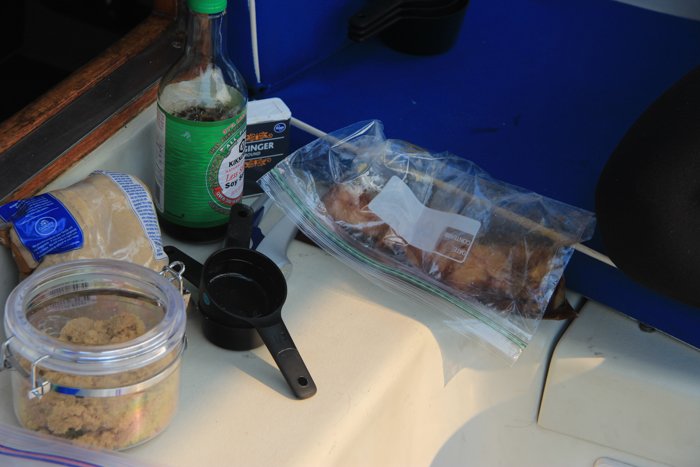
Marinating chicken in the cockpit since the swell in the Strait was too rolly to work below.

Last week we got back from our 4-week trip out the Strait of Juan de Fuca, up the west coast of Vancouver Island to Barkley and Clayoquot Sounds, back through the Strait to Victoria, around the Gulf Islands a couple days, and then back to Seattle.
This was about 600 nautical miles, but that’s just the straight line distance – with tacking and jibing when we were sailing, we probably did closer to 800.
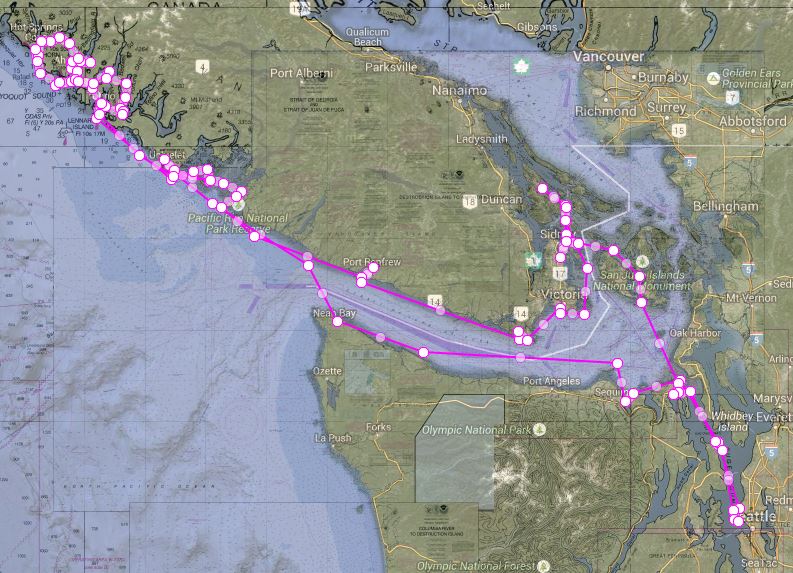
Overall route (not all circles represent stops, those are just the points where I needed to change the route line direction)

Detailed route of Barkley and Clayoquot Sounds.
As cruisers often say, the highs were very high and the lows very low. Cruising is often more intense, in both the good and the bad, than land life. Our two biggest problems were mechanical – the fuel filter clogging in the Strait of Juan de Fuca, and the transmission progressively failing. There were human challenges too – dealing with very tiring passages, mild seasickness, difficulties in confused ocean waves, challenges controlling the sails in high winds, and almost swinging into rocks at anchor.
Despite the challenges, I feel we did quite well. We didn’t have any failures of seamanship – no groundings, no navigational mistakes, no anchor dragging, no poor timing of weather, no docking mishaps.
There were hard times, but for this post I want to focus on the fun times – all the amazing experiences and especially the great photos I got.
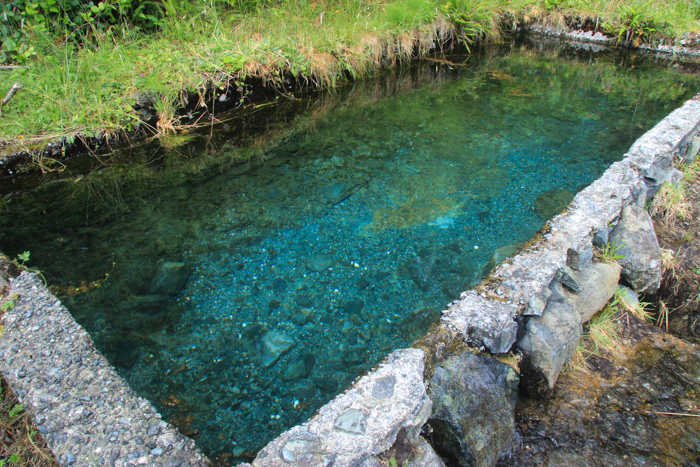
Stream-fed bathing pool at Matilda Inlet
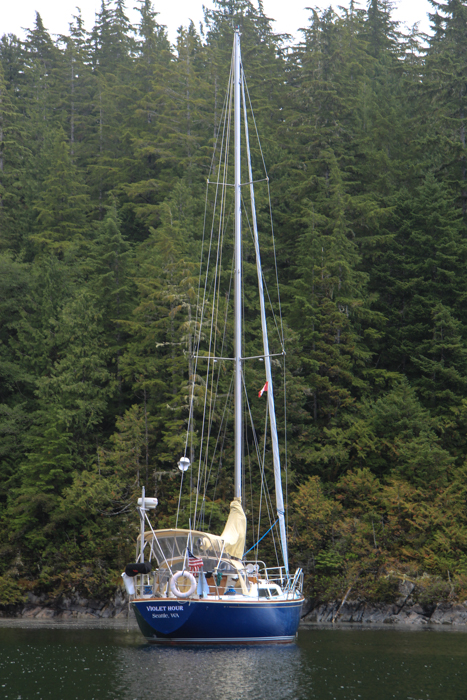
Anchored in Matilda Inlet (our favorite anchorage of the trip)
Wildlife
The trip was not a roadside safari, yet we saw plenty of wildlife.
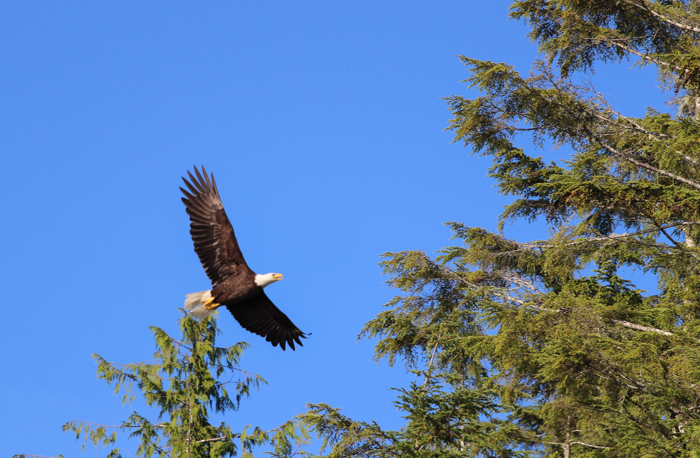
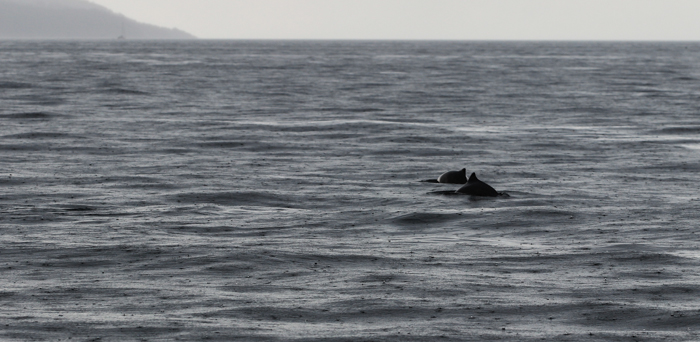
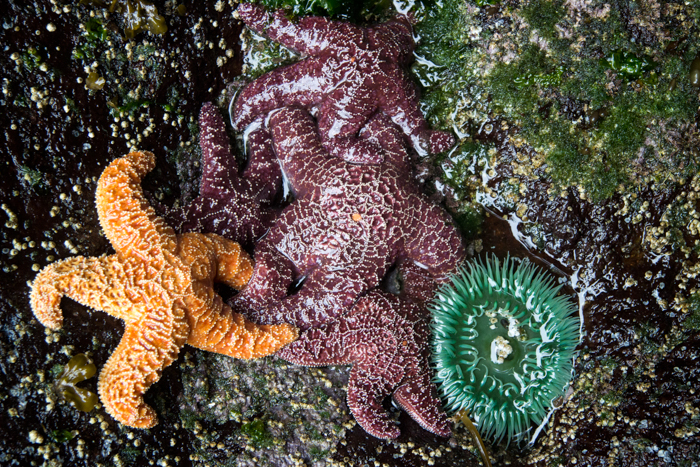
Great Hikes
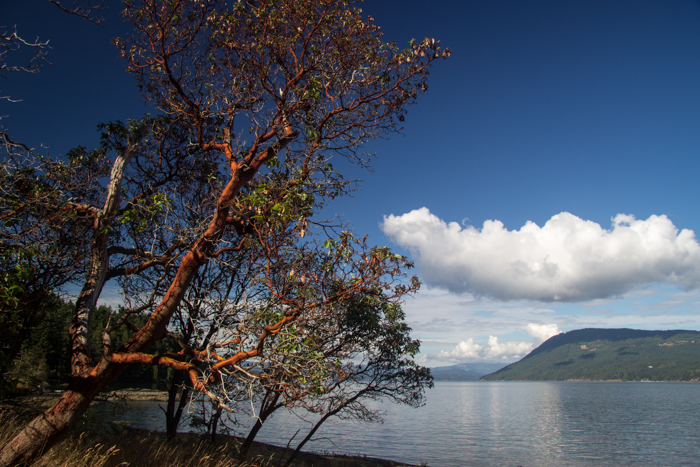
Portland Island
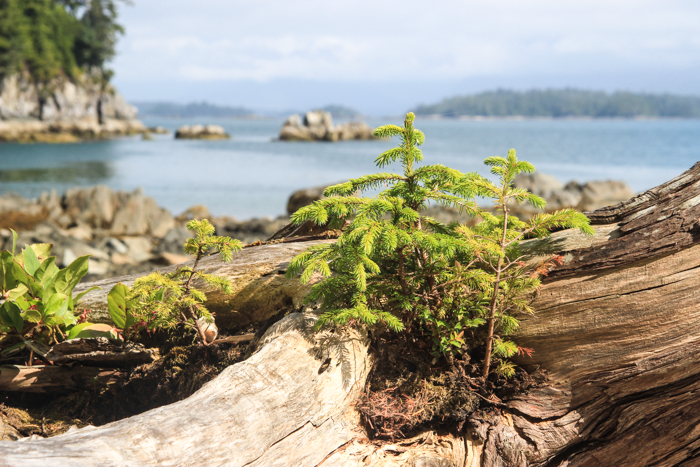
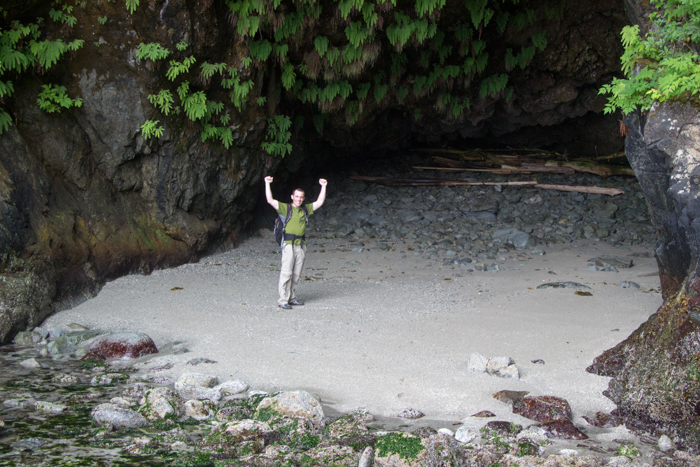
The sea cave at Effingham Island
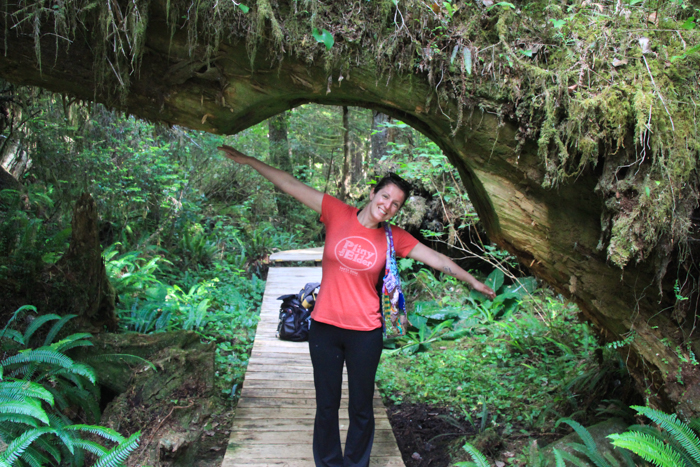
Hiking to the hot springs
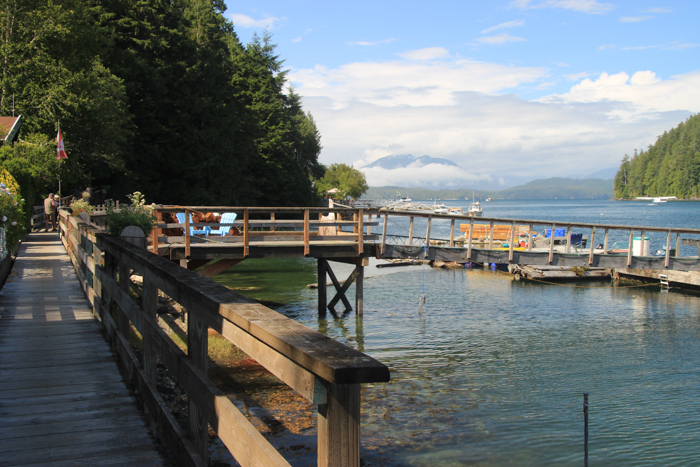
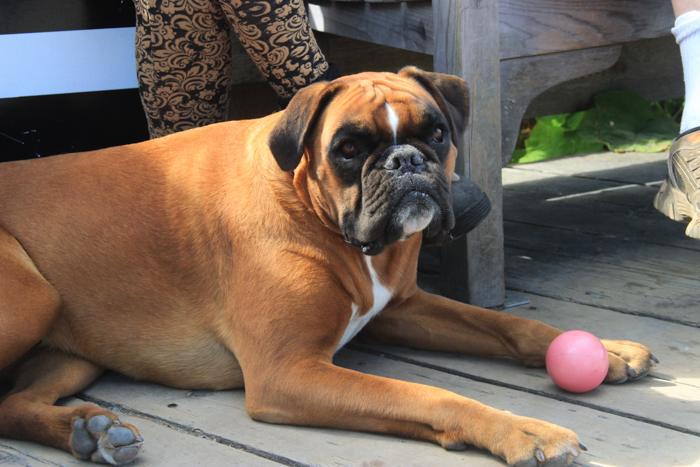
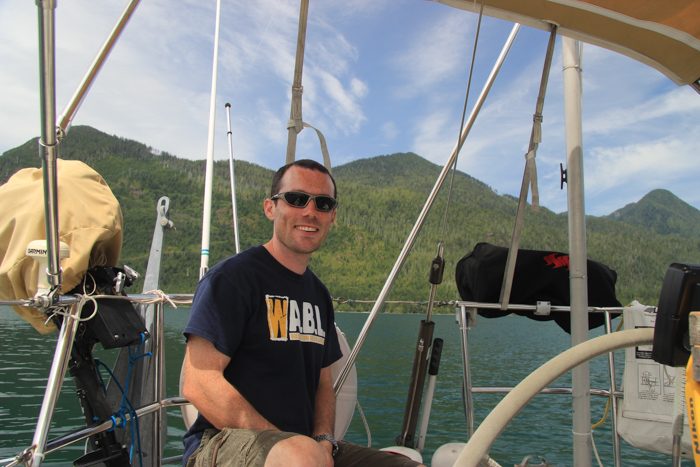
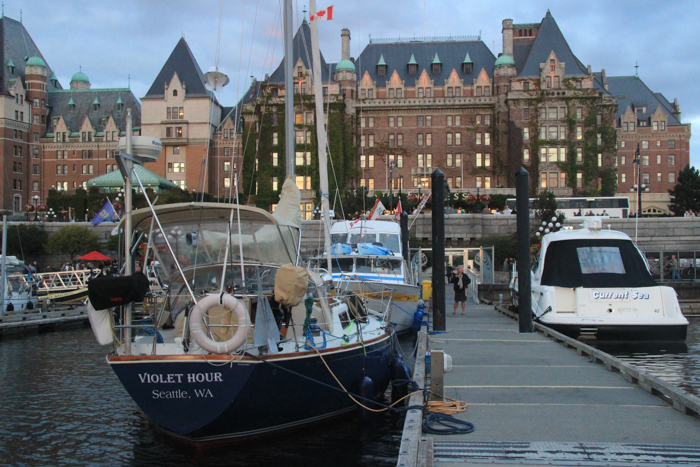
Arrived in Victoria and docked in front of the Empress Hotel
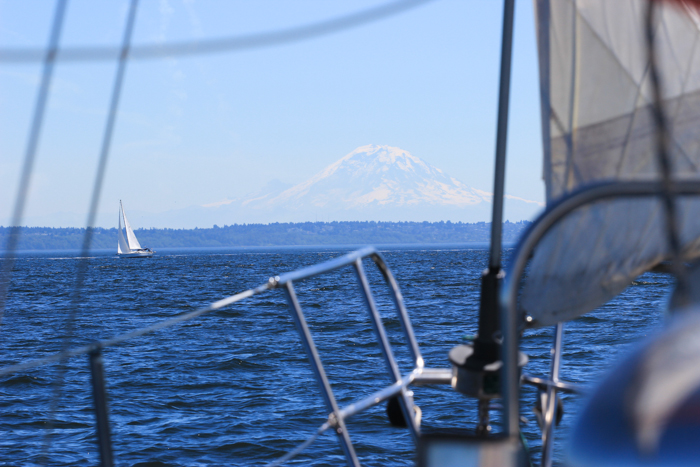
Our last day – with a failing transmission but a 12 knot wind at our backs, I pointed the bow pointed at Mount Rainier and we sailed home.